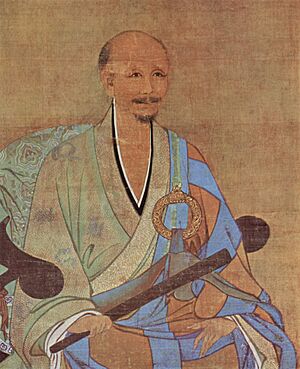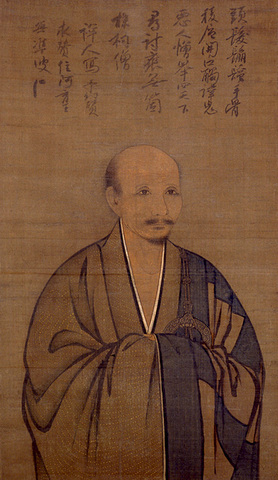Wuzhun Shifan facts for kids
Quick facts for kids Wuzhun Shifan |
|
|---|---|

Portrait of Zen master Wuzhun Shifan, painted in 1238, Song Dynasty.
|
|
| Religion | Buddhism |
| School | Ch'an |
| Personal | |
| Nationality | Chinese |
| Born | 1178 Sichuan Province, China |
| Died | 1249 China |
| Senior posting | |
| Based in | China |
| Title | Ch'an-shih |
Wuzhun Shifan (Chinese: 無準師範; 1178–1249) was a famous Chinese calligrapher and a Zen Buddhist monk. He lived during the later part of the Song Dynasty (960-1279), a time when China was very advanced in culture and art.
Contents
Who Was Wuzhun Shifan?
Wuzhun Shifan was born in a place called Zitong in Sichuan province, China. He became a Buddhist abbot, which is like the head of a monastery, at the Temple of Mount Jingshan.
Wuzhun's Meeting with the Emperor
In 1233, the Emperor Lizong of Song (who ruled from 1224 to 1264) asked Wuzhun to visit him. The emperor wanted to learn about Ch'an (Zen) Buddhism. Wuzhun shared his knowledge with the emperor. Because of this, Wuzhun was given a special title: Fojian Yuanzhao Chanshi. This means "Mirror of the Buddha, Zen Teacher." He also received a fancy gold-embroidered robe, which you can see him wearing in his portrait from 1238.
Wuzhun's Students and Influence
Wuzhun Shifan had many students who learned from him. One of his most important students was Enni Ben'en (1201–1280). Enni studied with Wuzhun in China from 1235 to 1241. After his studies, Enni brought Wuzhun's teachings back to Japan.
Enni helped make Zen Buddhism more popular in Japan. He also helped to establish the Tōfuku-ji temple in Kyoto in 1236. This temple became a very important place for Zen teachings in Japan.
Wuzhun's Art and Writings
Wuzhun Shifan was known for his amazing calligraphy, which is the art of beautiful handwriting. Some of his written calligraphy was given to his student Enni. You can still find these writings on plaques at the Tōfuku-ji temple in Japan.
A scroll of Wuzhun's calligraphy was even given as a gift to the powerful Tokugawa family and their leader, the shōgun. There is also a letter written by Wuzhun Shifan in 1242. This letter is now kept at the Tokyo National Museum and is considered a national treasure of calligraphy.
Wuzhun's writing also appears on a 13th-century Chinese painting called A Monk Riding a Mule. This painting is now in a collection owned by John M. Crawford Jr. It's possible that Wuzhun himself painted this picture, but we don't know for sure if he was the artist.
Wuzhun's Famous Portrait

Wuzhun's own portrait was painted in 1238 by an artist whose name we don't know. His student, Enni Ben'en, took this painting to Japan in 1241. Today, it is still located at Tōfuku-ji in Kyoto, Japan. This painting is so important that it has been named a National Treasure in the category of paintings.
The painting also has a message written on it by Wuzhun Shifan himself. Experts say it's painted in a special style for Zen priest portraits, called dingxiang or zhenxiang. In these paintings, the Zen monk usually sits in a special cross-legged position, wearing his full robes. His shoes are placed on a small stool below him, and he holds a whisk or a staff in his right hand.
See also
- History of the Song Dynasty
- List of Chinese people
- Culture of the Song Dynasty
- Chinese Buddhism
- Buddhist art

